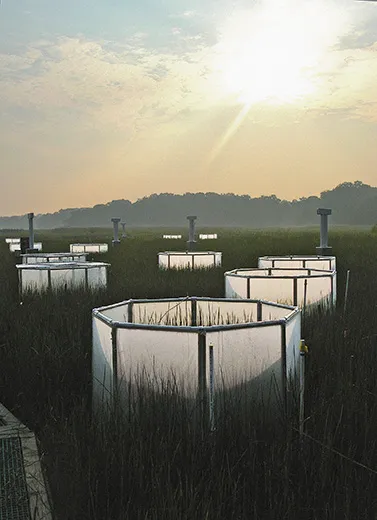How Will the Wetlands Respond to Climate Change?
Smithsonian scientists have taken to the Chesapeake Bay to investigate how marshlands react to the shifting environment
/https://tf-cmsv2-smithsonianmag-media.s3.amazonaws.com/filer/Coast-Guard-SERC-631.jpg)
In a tidal marsh on the shore of the Chesapeake Bay, dozens of transparent enclosures jut above the reeds and grasses, looking like high-tech pods seeded by an alien spacecraft. Barely audible over the buzz of insects, motors power whirring fans, bathing the plants inside the chambers with carbon dioxide gas.
To scientists at the Smithsonian Environmental Research Center (SERC) in Edgewater, Maryland, it’s the marsh of the future, a series of unusual experiments to simulate the effects of climate change and water pollution on a vital ecosystem. “What we’re doing out here is studying plant processes to predict the conditions of wetlands like this one—and tidal wetlands everywhere—in about 100 years,” Patrick Megonigal, a scientist at the center, says as he strides a boardwalk stretching into the 166-acre marsh.
The field study, stemming from an experiment first begun in 1987, is the only one of its kind worldwide that examines how multiple factors such as air and water pollutants will affect tidal wetlands—embattled ecosystems that will become even more important as a buffer against the storms and sea-level rise that are predicted to accompany global warming.
Made from PVC piping and clear plastic sheeting, each open-topped enclosure is a microcosm of a marsh under attack. Once a month, SERC scientists squirt nitrogen-rich water into the soil within the enclosures, replicating the fertilizer runoff that increasingly seeps into bodies of water like the Chesapeake. The plants are exposed to a carbon dioxide concentration roughly twice as high as that in today’s atmosphere; scientists have predicted that the higher level will be the norm by 2100, largely because of the burning of fossil fuels. The gas comes from the same tanks used in soft drink machines. “Our vendor tells us that we use more CO2 than Camden Yards,” Megonigal says of the Baltimore Orioles’ ballpark. “I actually calculated how many sodas that is, and it’s impressive: roughly 14 million 16-ounce bottles.”
Plants, of course, require carbon dioxide and nitrogen. But SERC studies have found, among other things, that some plant species grow more quickly when exposed to higher CO2 and nitrogen, while others show little response, a dynamic that could alter the overall makeup of the marsh. Still, predicting the consequences is tough. These excess nutrients boost plant growth and soil formation, which might counteract sea-level rise. But nitrogen also boosts microbe activity, accelerating the breakdown of biomass in the soil and reducing the wetland’s ability to serve as a carbon sink to offset carbon dioxide emissions.
Lately the researchers are examining a third environmental hazard: an invasive species. The tall, feathery grass Phragmites australis was introduced from Europe in the late 1800s through its use as a packing material aboard ships. In contrast to the native strain of Phragmites, the European version has become one of the most feared invasives in the eastern United States, aggressively displacing native species. In the SERC marshes, invasive Phragmites now covers 45 acres, roughly 22 times more than in 1972.
In greenhouse experiments, Megonigal and colleagues found that air and water pollution are a boon to the European Phragmites. With elevated carbon dioxide, it grew thicker leaves, allowing faster overall growth without any more water; with elevated nitrogen, it devoted less energy to growing roots and more to growing shoots. It was “more robust in nearly every plant trait we measured, such as size and growth rate,” Megonigal says.
In the chambers on the marsh, the Phragmites experiments look like a window into an unwelcome future: a perfect storm of climate change, water pollution and an exotic species poised to hit wetlands up and down the East Coast. A Phragmites invasion, Megonigal says, “has a cascading effect, with implications for food webs and the biodiversity of wildlife overall.”
/https://tf-cmsv2-smithsonianmag-media.s3.amazonaws.com/accounts/headshot/joseph-stromberg-240.jpg)

/https://tf-cmsv2-smithsonianmag-media.s3.amazonaws.com/accounts/headshot/joseph-stromberg-240.jpg)